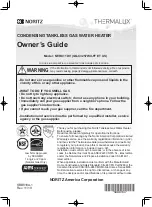
Starting up and shutting down
52
Instruction manual DR-RS
7
gis
7.4
The water heater’s
heating cycle
The water heater’s heating cycle is activated as soon as the measured water
temperature (T
water
) falls below the threshold value (T
set
). This threshold value
depends on the currently selected water heater operating mode. For example,
if the water heater is in the ’OFF mode’ (frost protection), then this value is 20°C.
If the water heater is in the ’ON mode’, then this threshold value is selectable,
for example, position 3 (60°C).
The heating cycle runs in turn through the following states:
1. Heat demand;
2. Zero state control by pressure switch;
3. Start fan;
4. Pressure difference in air supply;
5. Ignition of pilot flame;
6. Ignition of burner tray;
7. Running.
The complete cycle is explained in the example set out below.
n
Remark
The water heater runs through an identical cycle when frost protection is
activated.
1. The control thermostat sensor measures the water temperature. The water
temperature falls below the set temperature, e.g. 60°C, causing the control
thermostat to close. The burner control now detects a heat demand and
starts the heating cycle.
2. Once the heat demand is registered, the burner control runs a zero state
control on the pressure switch and the fan begins drawing air.
3. Once the air supply is guaranteed to be sufficient, the pilot flame is ignited.
4. Following ignition, once the pilot flame is verified by ionisation detection, the
burner tray is ignited: the water heater is now running. This means that
actual heating has started.
5. When the water is up to temperature, the heat demand cuts out. The gas
control closes and the pilot flame and the burner tray are extinguished.
With any subsequent heat demand, the heating cycle will resume from step 1.
Содержание DR-RS 105
Страница 2: ...2...
Страница 6: ...6 Instruction manual DR RS gis...
Страница 38: ...Installation 38 Instruction manual DR RS 3 is...
Страница 63: ...Instruction manual DR RS 63 A Electrical diagram DR RS is...













































